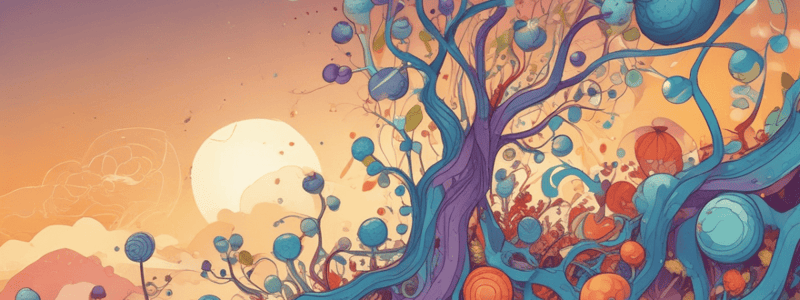Podcast
Questions and Answers
In the ATP/ADP cycle, ATP can act as a donor of low-energy phosphate to compounds above it in the table.
In the ATP/ADP cycle, ATP can act as a donor of low-energy phosphate to compounds above it in the table.
False (B)
What is the role of ATP in cellular metabolism?
What is the role of ATP in cellular metabolism?
ATP powers anabolic reactions, active transport of molecules and ions across membranes, and other energy-intensive processes such as muscle contraction.
The flow of electrons can do work in the cell, just like _______________________ transfer.
The flow of electrons can do work in the cell, just like _______________________ transfer.
phosphate
What is the term used to describe the potential difference between two half-cells?
What is the term used to describe the potential difference between two half-cells?
Match the terms with their descriptions:
Match the terms with their descriptions:
What is the direction of electron flow in redox reactions?
What is the direction of electron flow in redox reactions?
What is the purpose of maintaining a high ATP concentration in the cell?
What is the purpose of maintaining a high ATP concentration in the cell?
The free energy release of ATP hydrolysis is lower inside the cell than in standard conditions.
The free energy release of ATP hydrolysis is lower inside the cell than in standard conditions.
What is the purpose of ATP in cellular metabolism?
What is the purpose of ATP in cellular metabolism?
The three phosphates of ATP are susceptible to ________________ attack.
The three phosphates of ATP are susceptible to ________________ attack.
Match the following terms with their descriptions:
Match the following terms with their descriptions:
What is the equation for calculating ΔGp?
What is the equation for calculating ΔGp?
What is the major energy currency of the cell?
What is the major energy currency of the cell?
The standard free energy of hydrolysis of ATP is -30.5 kJ/mol under all cellular conditions.
The standard free energy of hydrolysis of ATP is -30.5 kJ/mol under all cellular conditions.
What is the process by which ATP is "earned" or "produced" in the cell?
What is the process by which ATP is "earned" or "produced" in the cell?
The hydrolysis of ATP involves the transfer of a _______________________ group.
The hydrolysis of ATP involves the transfer of a _______________________ group.
Match the following components of ATP with their descriptions:
Match the following components of ATP with their descriptions:
What is the result of the hydrolysis of ATP in terms of pH?
What is the result of the hydrolysis of ATP in terms of pH?
What is the term for the actual free energy of hydrolysis of ATP under intracellular conditions?
What is the term for the actual free energy of hydrolysis of ATP under intracellular conditions?
ATP is "spent" or "consumed" in exergonic reactions.
ATP is "spent" or "consumed" in exergonic reactions.
Flashcards are hidden until you start studying
Study Notes
ATP (Adenosine Triphosphate)
- ATP is the major energy currency of the cell, earned in exergonic reactions and spent in endergonic reactions via hydrolysis.
- ATP connects catabolism and anabolism.
- Components of ATP include:
- Adenine
- Ribose
- Triphosphate (three phosphate groups)
ATP Hydrolysis
- ATP hydrolysis is a reaction where ATP is broken down into ADP and Pi.
- During hydrolysis:
- Charge separation occurs, relieving electrostatic repulsion.
- Pi is stabilized by formation of a resonance hybrid.
- ADP2- immediately ionizes at pH 7, releasing a proton into the medium and lowering pH.
- Products (Pi and ADP) have a greater degree of solvation relative to ATP.
Phosphorylation Potential, ∆Gp
- The standard free energy of hydrolysis of ATP is -30.5 kJ/mol.
- In the cell, the actual free energy of hydrolysis of ATP (ΔGp) differs from the standard free energy change due to unequal concentrations of ATP, ADP, and Pi.
- ΔGp can be calculated using the equation: ∆Gp = ∆G´°+ RT ln ([ADP][Pi] / [ATP])
ATP Donates Phosphoryl, Pyrophosphoryl, and Adenylyl Groups
- Each of the three phosphates of ATP is susceptible to nucleophilic attack.
- ATP drives unfavorable reactions not by harnessing the energy of hydrolysis but rather through the coupling of group transfer to a substrate or enzyme.
- ATP can act as a donor of high-energy phosphate to compounds below it in the table.
- ADP can accept high-energy phosphate to form ATP from compounds above it in the table, forming an ATP/ADP cycle.
Cellular Roles of ATP
- ATP powers anabolic reactions through group transfer reactions.
- ATP powers active transport of molecules and ions across membranes.
- ATP powers other energy-intensive processes such as muscle contraction.
Biological Reduction-Oxidation Reactions
- Reducing agent: oxidation happens, loses electrons.
- Oxidizing agent: reduction happens, gains electrons.
- The flow of electrons can do work in the cell, just like phosphate transfer.
- Electrons flow from a reducing agent to an oxidizing agent due to their different electron affinities, which is called the electromotive force (emf).
- Redox reactions can be described as Half-reactions (GER-LEO).
Studying That Suits You
Use AI to generate personalized quizzes and flashcards to suit your learning preferences.




